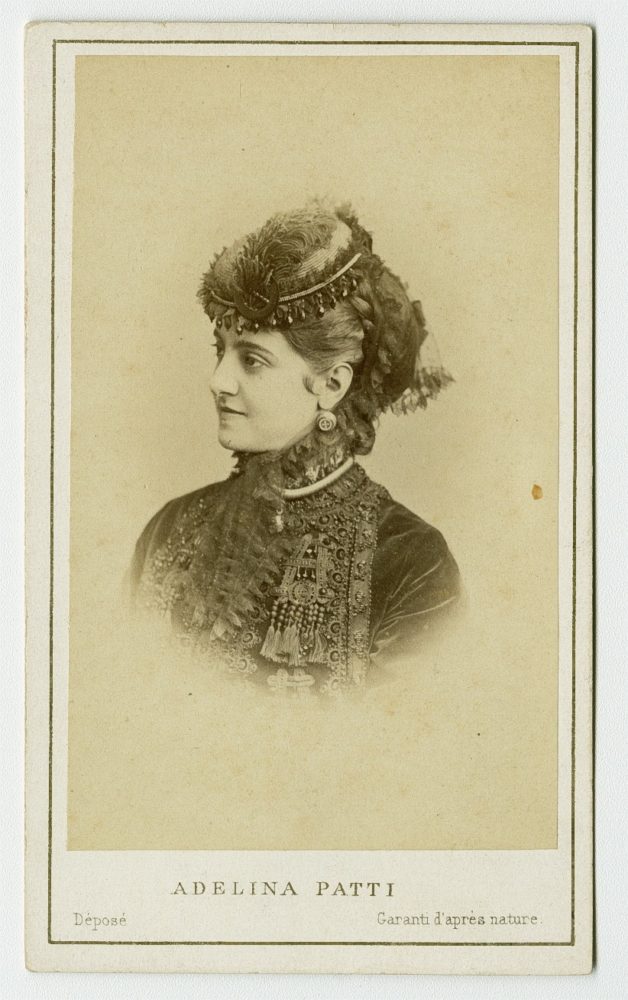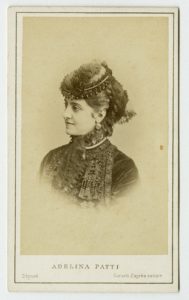Magazine
“The Last Rose of Summer” at the French Opera House
Popular songs reached nineteenth-century New Orleanians from the opera stage.
Published: August 30, 2018
Last Updated: November 29, 2020

The Historic New Orleans Collection, ACC.NO.1997.33.1
Adelina Patti ca. 1867
In 1805 the Irish poet Thomas Moore wrote “’Tis the Last Rose of Summer,” and the verse soon was adapted to a popular Irish tune. In 1813, both poem and melody were published in Moore’s A Selection of Irish Melodies.
The immediate popularity of the song is reflected in the speed with which it was taken up by dozens of composers of the day, most importantly by Ludwig van Beethoven in Vol. 2 of his “Irish Songs” (1816), by Felix Mendelssohn in his Fantasie Op. 15 “Letzte Rose” (1827), and then twenty years later in 1847 by Friedrich von Flotow, in what would be his most successful and enduring opera, Martha. The composer used the words and melody in the second act of the opera when Lady Harriet, in the guise of a servant girl, Martha, sings it at the request of a young farmer.
“The Last Rose” quickly spread worldwide in the opera’s original German and soon in a variety of translations, initially throughout Europe. In the United States, Martha premiered in 1852 in New York, followed by a performance in San Francisco, in both cases in English. It was in French that Martha and “The Last Rose of Summer” made its initial appearance in New Orleans, on January 20, 1860, at the Théâtre d’Orléans.
The 1859–60 season was unique. The city could boast of two large resident opera companies during the winter season—one at the ancient Orleans Theater, and the second at the new French Opera House, which was inaugurated on December 1, 1859. Three additional stagings of Martha followed at the Orleans. Then, on February 13, 1860, as if in competition, the opera was taken up and performed the same evening at both theaters. By the end of the season Martha had played seven evenings at each theater to rapturous applause, and the popular “Last Rose of Summer” guaranteed the opera’s success.
By the following season, however, the Orleans Theater no longer imported a resident troupe, and from that time, aside from an interruption by the Civil War, the French Opera House reigned supreme. And it was during that pre-war 1860–61 season that a second popular song made its local operatic stage appearance, although under completely different circumstances.
On December 19, 1859, Adelina Patti, age seventeen, destined to become one of the greatest sopranos of the century, made her local debut. During the season she was heard in seven roles, among them Lady Harriet in Martha, which she sang on four evenings.
Even though quite young and at an early stage in her lengthy operatic career, Patti embraced what was then a “tradition” by artists who sang the role of Rosina in Il Barbiere di Siviglia—the interpolation of arias and popular songs of the day during the “lesson scene,” at which point Rossini’s original music was abandoned in favor of a mini-recital by the diva. One of Patti’s favorite concert pieces was the song “Home, Sweet Home,” which on January 24, 1860, she included on the stage of the French Opera House in Barbiere, along with “’Twas Within a Mile O’ Edinboro’ Town” and “Swiss Echo Song.”
The extraordinarily popular “Home, Sweet Home” in fact had a connection to Italian opera, in a minor work by John Howard Payne’s 1823 Clari, or the Maid of Milan; the melody was by Sir Henry Bishop. An early printing of the song reportedly sold some one hundred thousand copies, and in 1852 Henry Bishop reissued it as a parlor ballad.
Like “The Last Rose of Summer,” it was taken up by other composers, perhaps most importantly by the noted concert pianist Sigismund Thalberg who, in 1857, wrote a series of variations on the theme for piano. Patti continued to sing “Home, Sweet Home” as part of her concerts. “The Last Rose” continued in the realm of popular music with interpretations by artists such as Bing Crosby, Deanna Durbin, Sarah Brightman, Charlotte Church, and James Galway.
Jack Belsom, a graduate of Tulane and Louisiana State Universities, has written extensively the rich history of opera in New Orleans. He is the archivist of the New Orleans Opera Association and writes for British Opera magazine.
